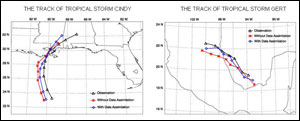For many people, a monsoon brings to mind images of intense rainfall and high winds in faraway places. Actually, monsoons occur all over the globe, including North America. These seasonal reversals of winds trigger dramatic changes in rainfall and other weather events within a short period of time.
The North American monsoon affects large areas of the southwestern United States and northwestern Mexico. This rainy season brings with it much more than torrential downpours from J

Data gathered from last year’s NASA hurricane research mission and a NASA satellite have improved tropical storm landfall and storm strength forecasts in computer models.
Ocean surface wind data gathered from NASA’s QuikSCAT satellite were combined with data from aircraft sensors dropped into tropical storms and fed into a new generation weather research and forecasting (WRF) computer model used to predict weather. The researchers in this study also used data from the Nationa
People, as they belong to the mammals, should be particularly interested in the problem of origin of this class in the animal kingdom that has conquered the entire world through evolution: not only the land, but, partly the ocean and the air. We have already known our ancient ancestors for long – these are medium-sized animals – eutherapsida (which means “real Synapsida”), they appeared at the end of the palaeozoic, approximately 270 million years ago, and continued to develop in the Age of
PACIFIC OCEAN, approximately 800 km west of Costa Rica¡ªAn international team of scientists aboard the research drilling ship JOIDES Resolution has¡–for the first time¡–recovered black rocks known as gabbros from intact ocean crust. Supported by the Integrated Ocean Drilling Program (IODP), the scientists drilled through the volcanic rock that forms the Earth’s crust to reach a fossil magma chamber lying 1.4 kilometers beneath the seafloor.
“By sampling a complete section of the
International collaboration brings up first samples of hard rock called gabbro in intact ocean crust
Scientists aboard the research drilling ship JOIDES Resolution have, for the first time, drilled into a fossil magma chamber under intact ocean crust. There, 1.4 kilometers beneath the sea floor, they have recovered samples of gabbro: a hard, black rock that forms when molten magma is trapped beneath Earth’s surface and cools slowly.
The scientists, affiliated with the Int
Ancient fish teeth are yielding clues about when Antarctica became the icy continent it is today, highlighting how ocean currents affect climate change.
University of Florida geologists have used a rare element found in tiny fish teeth gathered from miles below the ocean surface to date the opening of a passage at the bottom of the globe between the Atlantic and Pacific. The opening, which occurred millions of years ago in a much warmer era, allowed the formation of an ocean c